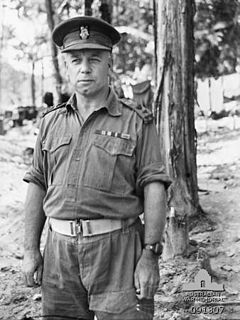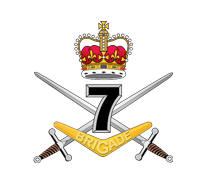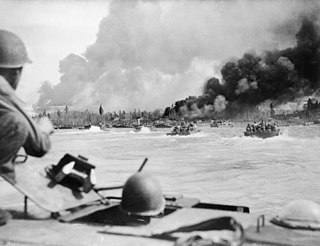| Milne Force | |
|---|---|
Location of Milne Bay within the Territory of Papua, 1942. The highlighted area is enlarged below. | |
| Active | July – 1 October 1942 |
| Country | Territory of Papua |
| Allegiance | Australia, United States |
| Branch | Naval, land and air |
| Engagements | Battle of Milne Bay |
| Commanders | |
| Notable commanders | Brigadier John Field Major General Cyril Clowes |
Milne Force was a garrison force formed in July 1942 during the World War II which controlled allied naval, land and air units in the region of Milne Bay, in the Territory of Papua. The force was responsible for constructing airstrips, roads, camps and defensive positions.

World War II, also known as the Second World War, was a global war that lasted from 1939 to 1945. The vast majority of the world's countries—including all the great powers—eventually formed two opposing military alliances: the Allies and the Axis. A state of total war emerged, directly involving more than 100 million people from over 30 countries. The major participants threw their entire economic, industrial, and scientific capabilities behind the war effort, blurring the distinction between civilian and military resources. World War II was the deadliest conflict in human history, marked by 50 to 85 million fatalities, most of whom were civilians in the Soviet Union and China. It included massacres, the genocide of the Holocaust, strategic bombing, premeditated death from starvation and disease, and the only use of nuclear weapons in war.

Milne Bay is a large bay in Milne Bay Province, south-eastern Papua New Guinea. More than 35 kilometres long and over 15 kilometres wide, Milne Bay is a sheltered deep-water harbor accessible via Ward Hunt Strait. It is surrounded by the heavily wooded Stirling Range to the north and south, and on the northern shore, a narrow coastal strip, soggy with sago and mangrove swamps. The bay is named after Sir Alexander Milne.

The Territory of Papua comprised the southeastern quarter of the island of New Guinea from 1883 to 1975. In 1883, the Government of Queensland annexed this territory for the British Empire. The United Kingdom Government refused to ratify the annexation but in 1884 a Protectorate was proclaimed over the territory, then called "British New Guinea". There is a certain ambiguity about the exact date on which the entire territory was annexed by the British. The Papua Act 1905 recites that this happened "on or about" 4 September 1888. On 18 March 1902, the Territory was placed under the authority of the Commonwealth of Australia. Resolutions of acceptance were passed by the Commonwealth Parliament, who accepted the territory under the name of Papua.
Contents
Milne Force successfully withheld a Japanese invasion which landed on 25 August during the Battle of Milne Bay and forced the invasion force to retreat on 5 September.

The Battle of Milne Bay, also known as Operation RE or the Battle of Rabi (ラビの戦い) by the Japanese, was a battle of the Pacific campaign of World War II. Elite Japanese naval troops, known as Kaigun Tokubetsu Rikusentai, with two small tanks attacked the Allied airfields at Milne Bay that had been established on the eastern tip of New Guinea. Due to poor intelligence work, the Japanese miscalculated the size of the predominantly Australian garrison and, believing that the airfields were only defended by two or three companies, initially landed a force roughly equivalent in size to one battalion on 25 August 1942. The Allies, forewarned by intelligence from Ultra, had heavily reinforced the garrison.
On 1 October 1942, Milne Force was redesignated the 11th Division.
The 11th Division was an Australian Army unit formed during World War II by the renaming of Milne Force in December 1942. Predominately a Militia formation, the division's main role during the war was as a base command headquarters, although elements saw action in New Guinea against Japanese forces during the Finisterre Range campaign and in New Britain. It was disbanded in July 1946.

















